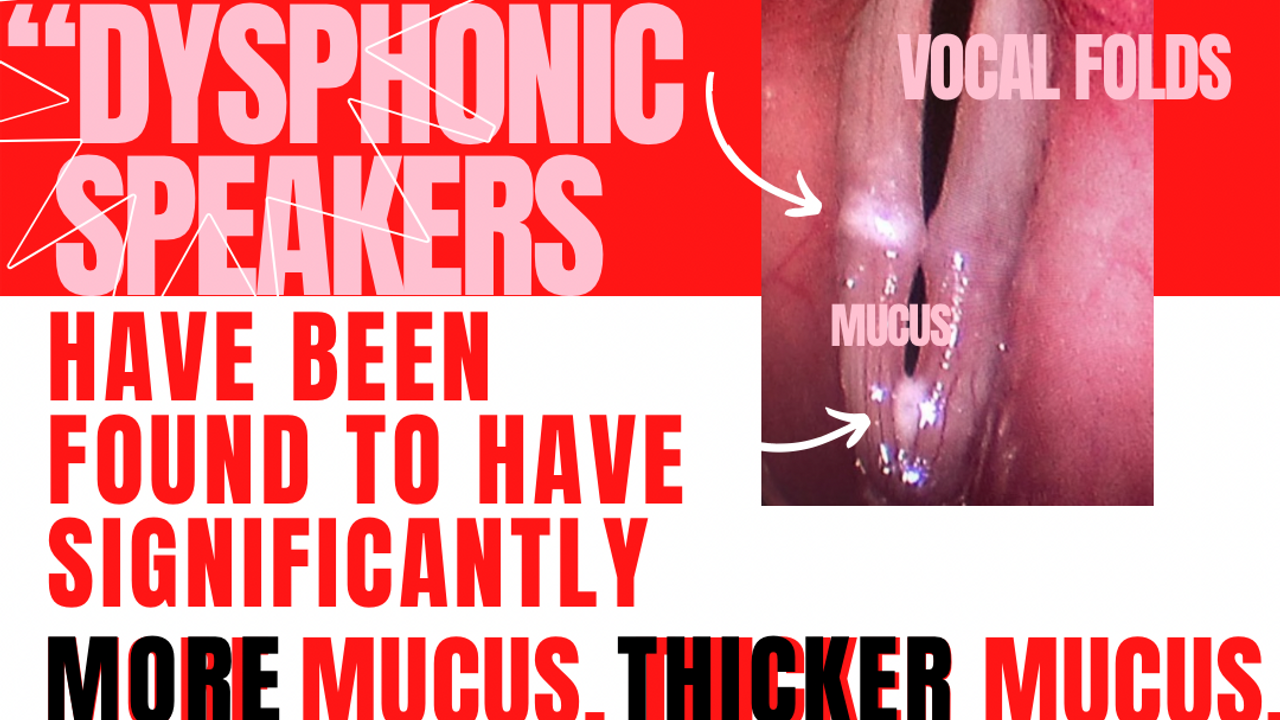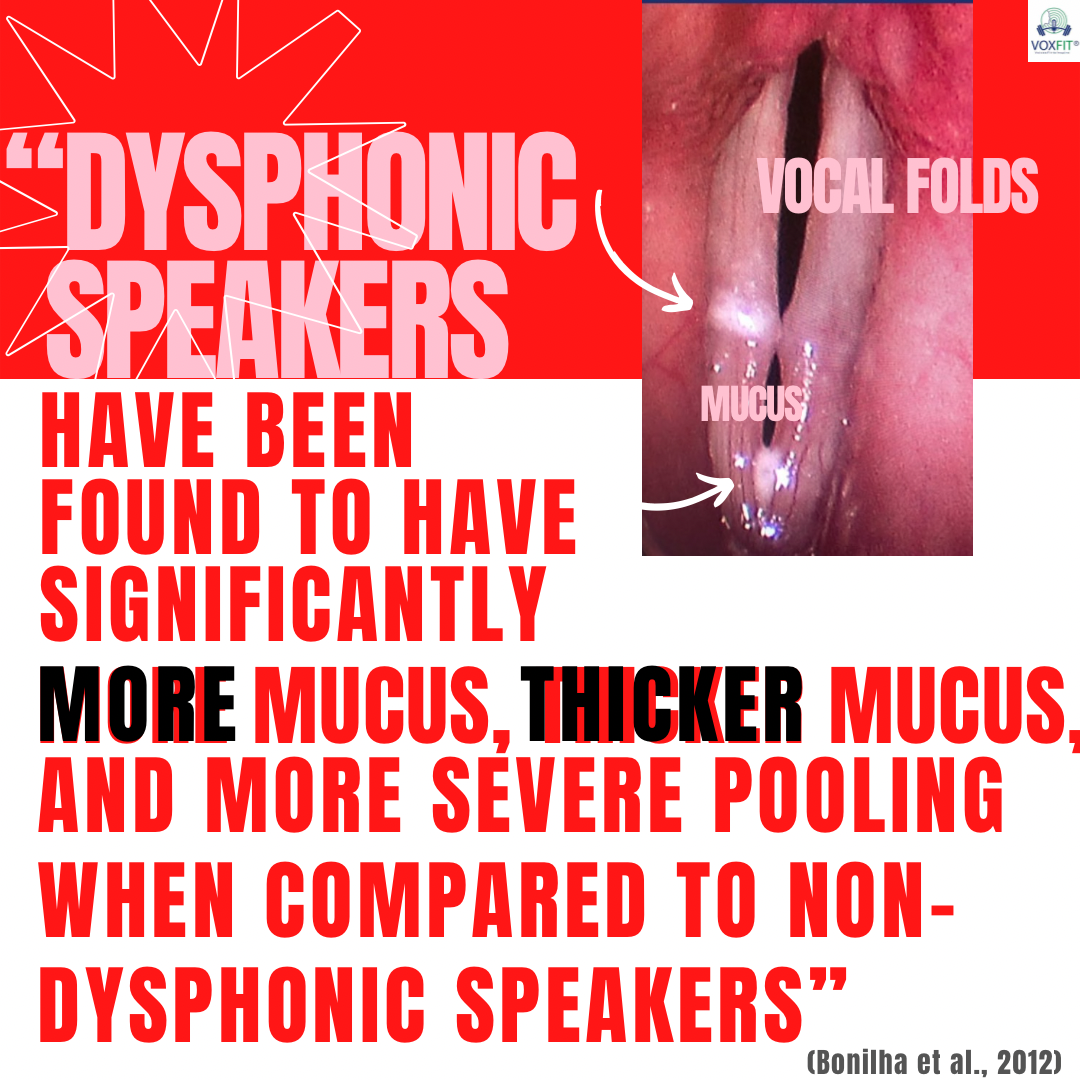Work Related Voice Disorders, MUCUS, and PYV!

The Week of September 5th BLOG:
Tuesday Toss Up: LOTS of Info on Work Related Voice Disorders

“HEALTH is a state of complete physical, mental, and social well-being, not just the absence of disease” (as cited in the Oliveira et al. article published in 2022).
.
.
What is your VOCAL health status? As an occupational voice user, this is DEFINITELY something important to consistently think about and prioritize.
.
.
In the context of workers’ health, several occupations use voice as a facilitating instrument for the performance of the professional functions. Those who depend on their voice to fully execute functions comprise a specific group called voice professionals (Przysiezny & Przysiezny, 2015).
.
.
“POPULATION ESTIMATES SHOW A PROGRESSIVE INCREASE IN THE NUMBER OF VOICE PROFESSIONALS IN MODERN SOCIETY” (Vilkman, 2004).
.
.
THE INCIDENCE RATES OF VOICE-RELATED DISEASES IN THIS POPULATION ARE EXPECTED TO INCREASE (2018).
.
.
Any form of vocal deviation related to the professional activity that reduces, compromises, or impede the worker’s performance or communication, (with or without an organic alteration of the larynx) is called a work related voice disorder (as cited in Oliveira et al., 2022). WRVDs are an important cause of the absence of work for voice professionals (Ferreira et al., 2021). They have a multi-dimensional effect on communication, professional performance, and quality of life… And can also create a socioeconomic impact, which can lead to early termination of careers or affect the learning of students, in the case of teachers (from the same article).
.
.
RESEARCH SHOWS THAT VOCAL DISORDERS AMONG VOICE PROFESSIONALS ARE MORE COMMON THAN THAT FOR THOSE IN THE GENERAL POPULATION (Martins etc al., 2014; de Jesus et al., 2020).
.
.

“There was a high prevalence of dysphonia in voice professionals, especially in the detection by auditory-perceptual judgment. High vocal demand and being a teacher influenced the increase in the prevalence of work-related voice disorders” (Oliveira et al., 2022).
.
The study aimed to analyze the prevalence of work-related voice disorders (WRVDs) among voice professionals and performed a huge meta-analysis including 561 articles (narrowed to 73) and a total participant number of 63,126!
.
“The class of professionals who need to use voice in high demand and moderate quality, especially teachers, has a higher prevalence rate of dysphonia than other professionals”. I consider INSTRUCTORS and COACHES a part of this “teacher” group too.
.
The emergence of research addressing the prevalence of dysphonia in voice professionals is related to the fact that, in modern societies, approximately ONE-THIRD of the world’s workforce involves professions in which VOICE is the MAIN OCCUPATIONAL TOOL (Vilkman, 2000).
.
The Oliveira et al. (2022) meta-analysis “found that the highest prevalence of WRVDs was identified through auditory-perceptual judgment, with a dysphonia prevalence of approximately 54% in the individuals evaluated”.
.
Research among teachers showed that these professionals were not concerned about mild vocal symptoms and sought treatment only when vocal quality diverted greatly and the occurrence of vocal signs and symptoms was prominent (Zambon, Moreti, & Behlau, 2014). The results of the meta-analysis reinforced the importance of auditory-perceptual judgment as a method of evaluation and diagnosis of dysphonia, as the perception of the affected individual about his/her voice problem may not be aligned with the severity of the condition (Ugulino, Oliveira, & Behlau, 2012). Oliveira et al. (2022) describes behavioral dysphonia (inefficient use of voice) as highly prevalent in voice professionals, (especially teachers) & not always associated with changes in laryngeal morphology (reinforcing the importance of the auditory-perceptual evaluation of these professionals to identify WRVD, since deviations in vocal behavior/quality may be present even before laryngeal changes).
.
Study results also reinforced that increased VOCAL DEMAND may be a risk factor for WRVD. Additionally, increased vocal demand also increases the VOCAL LOAD, leading to greater chances of a WRVD. Knowing this, and the significant prevalence of dysphonia among professional/occupational voice users (in this large study), don’t you want to re-assess your VOCAL BUDGET, VOCAL SCHEDULE, and/or general VOCAL HABITS? Doesn’t this make you wanna PRIORITIZE YOUR VOICE? :)
.
.
#voxfit #voice #prioritizeyourvoice #occupationalvoiceuser #work #workrelatedvoicedisorder #voicesfittoinspire #teacher #fitnessinstructor #singer #instructor #coach #clergy #publicspeaker #performer #salesperson #vocalfitness #bevocallyfit #beproactive #vocalhealth #vocalwellness #vocaldemand #vocalload #vocaldose #chooseyourbestvoice
Hump Day Health: MUCUS
Dysphonic speakers have been found to have significantly MORE mucus, THICKER mucus, and MORE severe pooling when compared to non-dysphonic speakers (Bonilha et al., 2012). Per the study, this was found to be especially true for hyper-functional speakers.
.
.
Inflammation of the vocal folds causes an alteration in the consistency of mucus, causing it to be more viscous. Thick, adherent/tenacious mucus may reduce amplitude and introduce turbulence as air flows over the rough and irregular vocal fold surface (Bonilha et al., 2012). This can contribute to a change in the quality of voice (dysphonia). And if the vocal folds aren’t vibrating well, the brain may tell the body to overcompensate (use hyperfunction) to produce voice, which can also lead to laryngeal irritation, more mucus production, feelings of globus sensation and tightness, and even habitual throat clearing.
.
.
Thick adherent/tenacious mucus may suggest reduced hydration of the vocal fold tissues. If you’re not adequately hydrated, your larynx will be more irritated and those vocal folds may not vibrate as efficiently as they should. You’ll also have thicker mucus as mentioned above, which may create a hypersensitivity in the laryngeal region and encourage you to clear your throat more often (which also further contributes more laryngeal irritation and more mucus production). Ahhhhhhh. Talk about a vicious cycle!! (And I see it A-L-L the tiiiiime).
.
.
PRIORITIZE YOUR VOICE (
 !!!) by soothing your larynx, eliminating habitual throat clearing, managing your mucus, and improving your hydration. You will feel SO much better. Happy #prioritizeyourvoicefriday !! How are YOU prioritizing your voice today? Let me know if you have any questions!
!!!) by soothing your larynx, eliminating habitual throat clearing, managing your mucus, and improving your hydration. You will feel SO much better. Happy #prioritizeyourvoicefriday !! How are YOU prioritizing your voice today? Let me know if you have any questions!

.
.
.
#voxfit #voice #mucus #vocalwellness #vocalhealth #manageyourmucus #prioritizeyourvoice #yesyoucan #letsgo #speechpathologist #voicetherapy #voicespecialist #voicespecialist #chooseyourbestvoice #vocalfolds #vocalfitness #bevocallyfit #takecareofyourvoice
PRIORITIZE YOUR VOICE!
It’s Prioritize Your Voice Friday… So how are you prioritizing your voice today? And everyday? As an OCCUPATIONAL VOICE USER, it should be one of your top priorities!
.
.
Shouldn’t PRIORITIZING your voice be high on your list?!
What do you need to know to keep your voice healthy? You should understand how the voice works, how to protect and care for your voice, and how to use your voice and entire vocal mechanism in the most efficient, effective, and dynamic ways possible.
.
.
I’m super PASSIONATE about this population of voice users (I’m one and most of you are too!), and am HERE TO HELP! Reach out with any questions, concerns, or if you’d like to work together.
.
.
#voxfit #desiretoinspire #aspiretoinspire #changelives #radiateconfidence #vocalinstrument #voice #voicefitness #vocalfitness #voicesfittoinspire #vocalathlete #occupationalvoiceuser #speechpathology #voicespecialist #teacher #instructor #fitnessinstructor #singer #performer #emcee #gamehost #clergy #sales #coach #speechpathologist #voicetherapy #voicedisorders #prioritizeyourvoice


